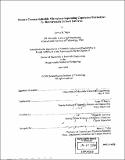Toward commercializable microphase-separating copolymer electrolytes for rechargeable lithium batteries
Author(s)
Trapa, Patrick E. (Patrick Ervin), 1976-
DownloadFull printable version (8.654Mb)
Other Contributors
Massachusetts Institute of Technology. Dept. of Materials Science and Engineering.
Advisor
Anne M. Mayes and Donald R. Sadoway.
Terms of use
Metadata
Show full item recordAbstract
Microphase-separating copolymers have been shown to possess the electrical properties of a polymer liquid and the mechanical properties of a solid. In the past, these materials had to be produced via anionic methods that are not easily scalable. To circumvent this problem, two approaches were adopted. In one, atom transfer radical polymerization (ATRP) was used to create the block copolymer, poly(oligo(oxyethylene) methacrylate)-b-poly(butyl methacrylate) [POEM-b-PBMA], which when doped with LiCF₃SO₃ (lithium triflate) exhibited good conductivity at room temperature ([sigma] [approximately] 3 x 10⁻⁶ S/cm at 23CÌŠ). The other approach used free radical techniques to prepare the graft copolymer, POEM-g-PDMS, starting with commercially available high molecular weight poly(dimethyl siloxane) [PDMS] monomethacrylate-terminated macromonomer. When doped with lithium triflate this material exhibited a conductivity of [sigma] [approximately] 8 x 10⁻⁶ S/cm at 23° C.This material was found to be stable up to [approximately] 300° C and flow resistant below an applied pressure of [approximately] 60 psi. In an effort to achieve single-ion conduction by Li⁺, the anionic charge was incorporated into the polymer backbone as a carboxylate. To prevent undesirable ion-pairing interactions two approaches were adopted: (1) tethering the anionic charge outside the conducting block of a block copolymer; (2) reacting the Lewis acid BF3 with the carboxylate to delocalize the negative charge. Both approaches produced materials with T[sub]Li⁺ = 1 while retaining conductivity ([sigma] <[or equal to] 7 x 10⁻⁶ S/cm) nearly identical to that observed in salt-doped systems. The self-doped electrolytes, however, demonstrated the ability to deliver stable currents at high drain rates, suggesting that immobilizing the anion improves rate capability. 100% solid-state cells consisting of lithium anodes, thin-film, fully-dense, vanadium oxide cathodes and microphase-separating copolymer electrolytes were operated for hundreds of cycles at discharge rates as high as [approximately] 1.5 C. Such batteries are conservatively projected to possess energy densities of 173 Wh/kg or 337 Wh/L. A design exercise optimizing a multilayer, thin-film battery configuration with the materials studied in this investigation speculated that specific energies exceeding 400 Wh/kg or 700 Wh/L may be attainable. The use of inexpensive materials and scalable processes in a simple design is expected to keep the cost of production low.
Description
Thesis (Ph. D.)--Massachusetts Institute of Technology, Dept. of Materials Science and Engineering, 2003. Includes bibliographical references (p. 106-113).
Date issued
2003Department
Massachusetts Institute of Technology. Department of Materials Science and EngineeringPublisher
Massachusetts Institute of Technology
Keywords
Materials Science and Engineering.